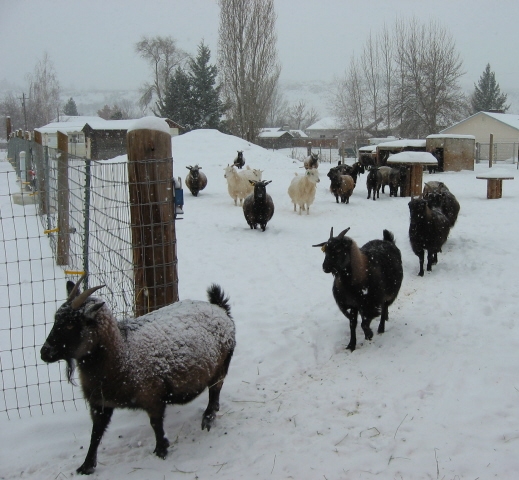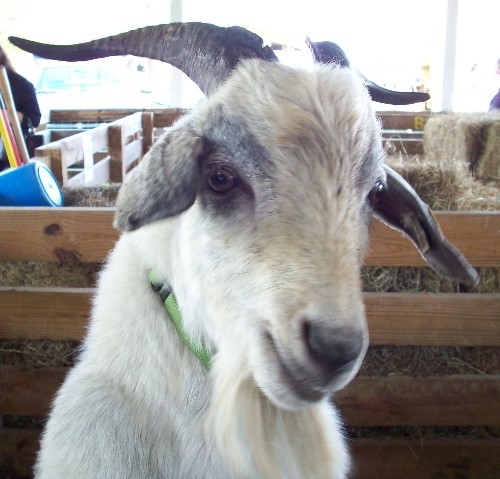Cashmere comes from Goats!?
The fine, soft fiber we associate with expensive sweaters and scarves is the down undercoat of goats.
"Cashmere comes from goats?!"
That’s right – the makings of every cashmere sweater starts out on a goat. Cashmere is the goat’s soft, downy undercoat, grown to its maximum length by mid-winter and shed in early Spring. Any goat (except an Angora goat) can grow cashmere, but those we call “cashmere goats” have been selectively bred to produce it in significant amounts.
The quality of the cashmere fleece is determined by three factors: its length, its diameter, and the degree of crimping. The American cashmere industry promotes high standards for raising good healthy animals bearing exceptionally good cashmere fiber. The Cashmere Goat Association has also defined a standard for a breed identified as the North American Cashmere Goat.
"But cashmere goats all look so different!”
That’s because there is no such thing as a “purebred” cashmere goat, although individual goats who meet the North American Cashmere Goat standard can be registered as NACG goats. Feral goats from Australia, and Spanish meat goats from the American Southwest, selected for fiber traits, form the basis of the American cashmere goat industry. The goats’ down and the guard hair which surrounds it may be any color, but the shearable parts of the body (excluding face, stockings and belly) should be of a single color.
The guard hair may be long or short depending on individual situations and preferences, but the guard hair should be coarse enough that a mechanical dehairer can easily distinguish it from cashmere. Traditionally, cashmere goats are not de-horned. Both male and female goats have horns, which serve to dissipate heat during the summer, and make excellent handles when working with the animals.
“So how many goats does it take to get enough cashmere to make a sweater?”
Most of the hair on a cashmere goat is guard hair. The downy undercoat is the cashmere. Either of two methods are used to harvest the cashmere fleece – shearing or combing. Sheared fleece contains considerably more guard hair than combed fleece. No matter which method is used, the harvested fleece must be dehaired in order to remove the guard hair.
The average cashmere yield from one goat amounts to about four ounces annually, but there is a wide range of variation in yield. Fiber length and fineness, and the amount of fleece coverage on the goat’s body, as well as the overall size of the goat, determine yield.
“What exactly makes this fiber ‘cashmere’?”
Cashmere fiber is crimped (rather than wavy), soft, and lacking luster. By industry standards it must be at least 1-1/4′ long with an average diameter less than 19 microns. A micron is one-millionth of a meter (a meter is about a yard), so each fiber is very, very fine. For comparison, a human hair can range from 17 to 181microns in diameter. The crimpiness of the fiber gives it “loft” and enables garments made of cashmere to provide warmth without weight.
Notice how every soft fiber is compared to cashmere, as in “this is as soft as cashmere.” Purists think nothing is as soft as cashmere! “Pashmina” is a marketing term, not a specific fiber. Pashmina shawls are made of a fiber blend of cashmere and silk. Another confusing term is “cashgora” Since angora (mohair) goats also produce fiber, and a lot of it, attempts were made to breed them to cashmere goats to increase yield. What resulted was a long, wavy, lustrous, coarser fiber that can’t be called cashmere. Hence cash+gora from the combination of the goat names. Most cashmere breeders find a tendency to produce cashgora undesirable in their goats.
“But I heard that combing out cashmere can be harmful to the animals. Is that true?”
That is utterly untrue. PETA has posted a statement saying that when goats are combed in the cold weather, they can become overly chilled and can even die. The reality is that cashmere goats shed their undercoat naturally, and cashmere goat owners only comb their animals when they start to shed. If we didn't comb it out, the goats would rub against the feeders and fence posts and deposit all of the cashmere there! Rest assured - no harm comes to goats through the combing of the cashmere.
“How do I go about buying a cashmere goat?”
First of all, don’t even think of buying a lone goat! Goats are herd animals and become extremely unhappy when they are alone. (A goat does make a good companion for a horse, however!) That said, it’s important to do your homework before jumping into goat ownership. Learn as much as you can about the animals.
Attending one of CGA’s seasonal goat shows would be a good start. We’re always happy to talk about our goats. Try to visit as many farms as possible to see a variety of animals and styles of goat management. (If you visit during kidding time, usually early Spring, be forewarned that there is nothing more appealing than a baby goat!)
Look for healthy, alert animals that move easily on sound legs and are well fleshed out. Take time to feel the animals. Check to see if the teeth meet the dental pad squarely and that the relevant reproductive parts are properly formed. Ask questions.
Learn to recognize cashmere: crimpy, fine down, surrounded by much coarser guard hair. If the goats have been shorn or combed, ask to see last year’s fleece. Decide on what kind of guard hair will work best for your situation and personal preferences. Be certain that you and the seller agree on the terms of the sale. Ask questions. Avoid misunderstanding.
“Then what? How do I take care of these animals?”
To back up a step, you obviously must have a place for the goats to live. Good fences will protect goats from predators, gardens from goats, and goat owners from neighbors who don’t take well to caprine visitors. Generally, peripheral fencing of woven wire having about six inch openings works well. A single strand of electrified wire about eight inches above the ground (outriggers) will prevent kids from getting their heads stuck while reaching for the greener grass on the other side of the fence. Five strands of electric fencing, sheep fencing, existing fences can be upgraded by installing an electric outrigger — but talk to five different goat owners and you will get five different suggestions! Each farmer has his or her own favorite kind of fencing.
Although cashmere goats are rugged and adaptable and can survive with minimal housing, they need shelter from wind and wet weather. A clean, dry barn or shed can prevent hoof problems, internal parasite problems, and kidding losses due to hypothermia or frostbite. A three sided shed affords an effective wind break and keeps their bedding straw dry.
Hoof trimming and parasite control are important parts of goat management, although frequency of worming and trimming depends on climate and terrain. Parasite control is more frequently needed if pastures are not rotated and there is egg buildup in the soil.
Try to find a vet nearby who is familiar with small ruminants, since there will be times you need a professional such as emergency situations.
“What do they eat?”
Not tin cans. Actually, goats are discriminating eaters, often plunging into an offering of hay to find just the tastiest piece. But they are incurably curious, and will nibble on anything that interests them — buttons, shoelaces, gloves — to see if it’s edible
Goats eat pasture and browse in the summer; they eat hay in the winter. A good pasture will support about five goats per acre. A rough estimate of hay consumption is one square bale per head per week. With an available supply of fresh clean water, an occasional supplement of grain (especially in periods of extreme cold or stress, during rutting and prior to kidding and during lactation), and a small amount of mineral supplements, these animals will thrive.
"Okay, I’d like to meet some goats and get started on my journey toward cashmere goat ownership.”
Great! We’d like to see many more cashmere goat farms throughout the country. On this website you will find CGA members who will be happy to give you more information. Most of us were not”farmers” before getting our animals, and now most of us can’t imagine being without these wonderful creatures. Pick a starting point, and get busy – your cashmere goats are waiting!


